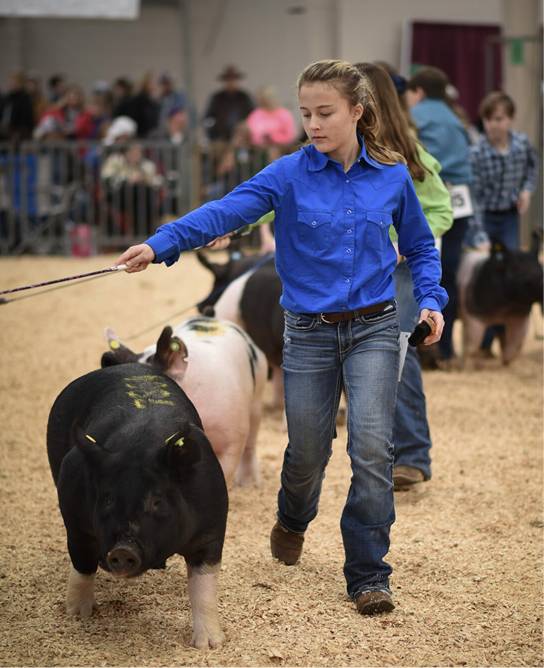Keeping Your Livestock Show Animals Healthy: Proper Drug Use
Proper pharmaceutical use in food animal species gives consumers confidence that the food they buy is wholesome and safe to eat. Proper pharmaceutical use is also the law! The drug use rules at the Mississippi State Fair and the Dixie National Junior Roundup (DNJR) are intended to ensure a safe food supply while upholding state and federal laws governing the use of products used in food animals. Regardless of use, cattle, pigs, sheep, goats, poultry, and rabbits are considered food-producing animals.
The Food and Drug Administration (FDA) approves all products such as vaccines, antibiotics, feed additives, and other pharmaceuticals used in food animal species to ensure that potentially harmful residues do not enter the food supply. They establish and enforce rules about acceptable levels of residues. For some substances, no amount of residue is acceptable. It is illegal to sell animals or animal products that contain residues exceeding FDA limits. The FDA also establishes withdrawal times for products to ensure that unacceptable residues are not in an animal when it is marketed.
Violative residues may occur from improper use of antibiotics (injectable, water, powder, bolus forms), feed medications, and pesticides near harvest. Treatment of animals before or during the show requires careful selection of products to avoid those with extended withdrawal periods. Common errors that may lead to illegal residue include inadvertently feeding a medicated feed requiring a withdrawal period and improper selection of therapeutic drugs immediately before or during the fair. Use of tranquilizers or sedatives to calm animals during the fair or exhibition is illegal because no tranquilizers or sedatives have been approved in food animals for this purpose. Further, the use of tranquilizers can result in violative tissue residues.
Exhibitors are responsible in ensuring that residues – whether intentional or unintentional – are not present in their animals. Most residues that have been found in show animals are the result of unintentional or accidental exposure.

Here are some examples of pharmaceutical use in show animals that have led to disqualification:
- Using a generic flunixin meglumine (i.e banamine) not labeled for the species
- Exposure to nicotine from tobacco or energy drinks
- The use of human over-the-counter medications (Tylenol, aspirin, pepto-bismol)
- The use of human over-the-counter topical medications (pain gels and lotions)
- Administering an off-label antibiotic without veterinary direction
- Feeding ractopamine to breeding swine and breeding beef animals
- Feeding coffee grounds, chocolate, or other stimulants to food animals
The key to residue avoidance is simple – use pharmaceutical products only according to their label instructions! Livestock exhibitors must follow label instructions on all animal drugs, including those given to livestock that are brought to the fair.
Important Facts
- All livestock show animals are considered food-producing animals, regardless of whether they are being raised for market. By law, there is no “pet” food animal!
- Exhibitors are responsible in ensuring that residues – whether intentional or unintentional – are not present in their animals.
- Just because you can purchase a product does not mean it is allowed under law to be administered to a food-producing animal.
- By law, every animal drug must be approved by the FDA for all uses before it is available for producers to buy. Approved substances will have an “Approved by FDA” statement on the label.
- Many “all-natural” products such as supplements and calming agents are not FDA approved and thus are illegal to use.
- You cannot use vitamin shots not approved for your species of animal.
- Products such as melatonin, CBD, and caffeine are illegal to use as they are not labeled for food animals.
- You will always find the withdrawal times printed prominently on the label. If a product does not specify a milk or meat withdrawal time, it may not be legal for food animal use!
- Sedatives are only legal for medical issues and must be given under the direction of a veterinarian.
Important Do’s
- Do always involve a veterinarian in treatment decisions
- Do only use products that are FDA or EPA approved for use in your food animal species
- Do follow label instructions exactly (species, dose, route, etc.)
- Do read all product labels to determine the appropriate withdrawal time
- Do keep meticulous treatment and feed records for your animals
Important Don’t’s
- Don’t use any animal or human over-the-counter drugs without veterinary direction
- Don’t use prescription products given to you by anyone other than a veterinarian
- Don’t present an animal to be marketed unless sufficient time has passed to complete the withdrawal period
- Don’t allow milk from treated animals to be consumed until the proper milk withdrawal has been met
- Don’t feed any animal food not made specifically for your species of animal
- Don’t be afraid to ask questions if you are unsure of a treatment or recording requirement
If you have questions about a specific product or reporting requirement, be sure to ask your veterinarian! Developing and maintaining a good veterinary-client-patient relationship (VCPR) helps protect your animals’ health. A VCPR exists when your veterinarian is familiar with your operation and knows enough about your animals to be able to prevent, diagnose, and treat medical conditions they may encounter. A VCPR is also required in many cases for the dispensing of medications, including prescription medications, and in any case where an approved medication (prescription or over-the-counter) is administered off-label. Livestock show veterinarians may be available to answer general questions about pharmaceutical use and record-keeping, but are unable to provide specific guidance on withdrawal time of products administered off-label by your veterinarian or any other provider.
Remember, our goal is to provide a fun, safe, and educational experience for all show participants!
Understanding and following the rules will make the overall livestock exhibition experience enjoyable to everyone.

Frequently Asked Questions
Question: If an animal becomes sick within five (5) days prior to the show, can it be treated with antibiotics and still shown?
Answer: Yes, the animal can and should be treated for health and welfare purposes. The animal can still be shown if the animal is treated per State Fair/Dixie National Junior Roundup guidelines, and the treatment is written on the animal’s 60-day 4-H/FFA Health Record Form. The exception is that the administration of any anti-inflammatory within five (5) days will disqualify the animal from showing. Depending on the condition of the animal, quarantine or removal from the fairgrounds may be recommended to keep the animal from transmitting any infection to other animals.
Question: A vet prescribed an anti-inflammatory drug (e.g., flunixin, dexamethasone) three (3) days ago. The label withdrawal time is four (4) days. Can the animal be shown tomorrow?
Answer: No, because anti-inflammatory agents can also be considered performance-enhancing drugs. Per the State Fair/DNJR rule, “Performance enhancing drugs (including, but not limited to; steroids, diuretics, anti-inflammatories, tranquilizers and pain killers) may not be administered five (5) days prior to showing the animal.” Exceptions to this rule include the use of anti-inflammatory drugs in dairy cattle. Dairy exhibitors should check the rule book for current regulations.
Some examples of anti-inflammatory medications include products containing aspirin, acetaminophen, flunixin meglumine (i.e., Banamine®), steroids (dexamethasone, prednisolone), local anesthetics, including topical (lidocaine). This is NOT an exhaustive list; contact your veterinarian if you have questions on the use of a particular product.
Question: Can a calming agent such as “pig calm” be used in show animals?
Answer: Calming agents can be used in show animals only if they are FDA approved and given per label directions. Any other use would be considered “off-label” and must have veterinary approval.
Question: Can a muscle repartitioning agent such as ractopamine or zilpaterol be used in show animals?
Answer: Yes, but only as per the FDA-approved label, and it must be listed on the 60-day 4-H/FFA Health Record Form. Market hogs and market cattle can be fed these substances but feeding them to a breeding animal would be considered a violation of FDA regulations. Off-label feeding of any animal medication is strictly prohibited by FDA regulations. Commercial animals (gilts and heifers) are not considered market animals, and by law cannot be fed these products.
Question: Can estrus synchronization products such as Matrix® or CIDRs® be used in show animals?
Answer: Yes, if they are used per the FDA-approved label to suppress heat in females for purposes of reproductive management. Their use must be listed on the 60-day 4-H/FFA Health Record Form.
Publication 3689 (POD-09-21)
By Dr. Carla Huston, Beef Extension Veterinarian and Professor, CVM Pathobiology and Population Medicine.
The Mississippi State University Extension Service is working to ensure all web content is accessible to all users. If you need assistance accessing any of our content, please email the webteam or call 662-325-2262.





